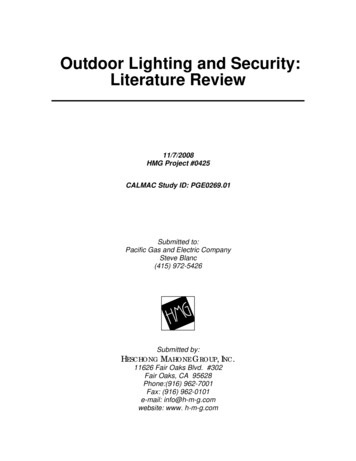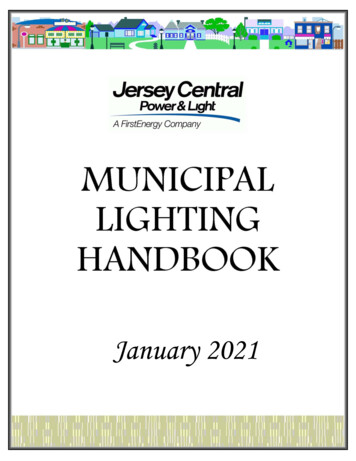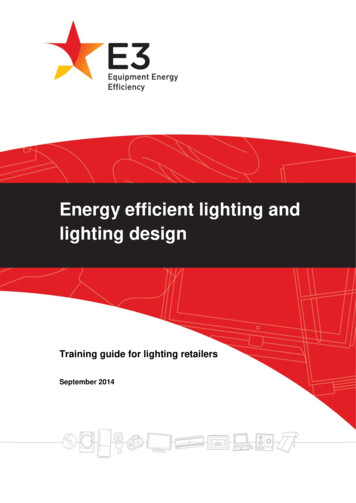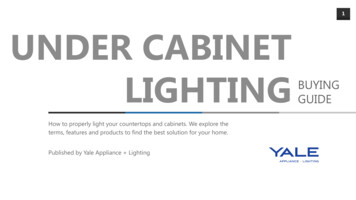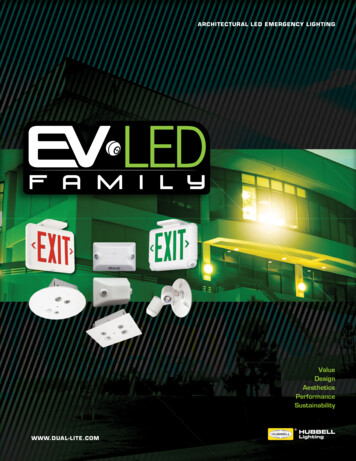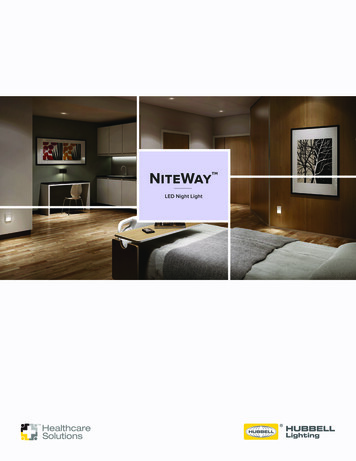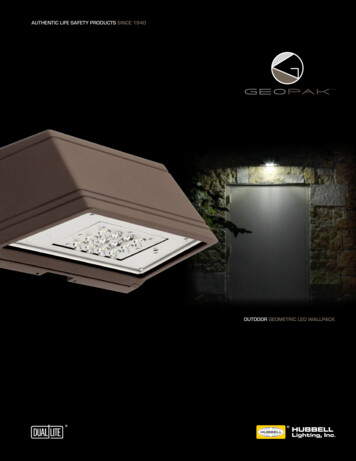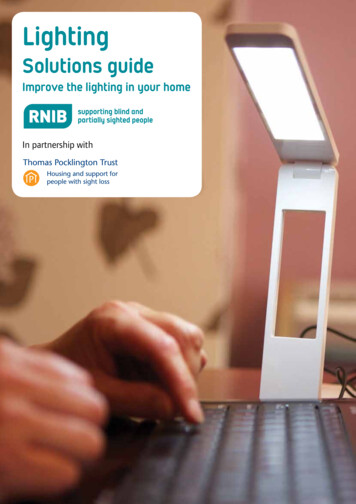
Transcription
LightingSolutions guideImprove the lighting in your homeIn partnership with
ContentsIntroduction2Eyecare3Why is lighting important?4What difference can better lighting make?4Different types of light5Lighting your home8Different types of bulbs and measurements11Choosing light fittings14Choosing additional lighting15Practical help and advice on making your home safer and brighter20Organisations offering information and support22IntroductionThis booklet has been produced by Royal National Institute of Blind People(RNIB) and Thomas Pocklington Trust. It explains good practice by giving ideas,hints and tips on how to light your home effectively with different types ofhousehold and task lighting, and the potential benefits for people experiencingsight loss. At the end of the guide you will find details of practical help andsupport available from a range of organisations.RNIB supports blind and partially sighted people and is the UK’s leading charityoffering information, support and advice to anyone with a sight problem. Ourspecialist range of products help blind and partially sighted children and adultslive independently. Examples from our lighting range are featured throughoutthis catalogue with order codes listed in brackets. You can buy these on ourOnline shop or through our network of shops and resource centres.Thomas Pocklington Trust is a leading provider of housing and supportservices for people with sight loss and a major funder of social research aboutsight loss. Our research findings have informed this booklet and other practicalguidance on housing design and lighting in the home.2pocklington-trust.org.uk
EyecareLooking after your sight is very important.A regular eye examination can identifyconditions before you are aware of anysymptoms. It can ensure you are wearingthe correct spectacles to make the mostof your vision, or start the referral processto appropriate treatment. Sight tests arefree of charge to some people includingthose: aged over 60; under 19 in full timeeducation; in receipt of certain benefits;who have, or whose relatives have certainhealth conditions. Some people are eligiblefor reduced cost or free spectacles via theNHS voucher scheme. If you are unable to visit a high street optometrist, youmay be entitled to an eye examination at home. For information on local servicesask your GP.Low vision servicesA low vision assessment may be available to you to find out about effectivetechniques and products that could help with everyday tasks including readingand watching TV. Low vision services may be based in a local hospital oropticians, offered in the community or by a local society for blind and partiallysighted people. To find out about local services and how to get an assessmentask your GP, hospital eye department, or Local Authority Sensory team. As wellas an assessment you may be eligible for suitable equipment free of charge.Resource centresIf you would like to try equipment beforeyou buy, or ask questions about productsand services, then a resource centre inyour area might be able to help. Thereis a network of centres and mobiledemonstration units throughout the UKrun by, amongst others, RNIB, Action forBlind People, local charities and communityequipment services. Contact RNIB Helplineon 0303 123 9999 to find one close to you.rnib.org.uk/lighting3
Why is lighting important?Everyone needs good levels of light and as we get older these needs increase.Light entering the eye is focused on the retina at the back of the eye, whichtransmits the visual image to the brain. As your eye ages, less light reaches theretina. Most people aged 60 need three times more light than when they were 20.Most people with sight loss need and benefit from enhanced lighting. However,some eye conditions cause people to experience glare problems in normal lightlevels, which could be uncomfortable or even intolerable for them.Light entering an older eye is more “scattered”, which can make objects moredifficult to see because contrast is reduced. For example, the edges of stepsmay be hard to see, and colours may not be as clear as they used to be. Someeye conditions can make this scattering worse.Sometimes your eyes need more time to adapt to varying lighting levels withinyour home. Some people find when they go from a bright room to a darkroom it may take several minutes for their eyes to adjust to the new levels.Having consistent, even and controllable lighting levels throughout your homeis important.What difference can better lighting make?Good lighting can make the most of sight by increasing contrast and clarity,making it easier to carry out everyday tasks. It can help you stay independent,move around your home easily and safely, continue with, or take up hobbiesand interests and help you stay involved with life around you.General lighting should give even illumination, avoiding shadows and dark areas.Brightness levels should be similar in adjacent rooms to avoid your eyes havingto adjust when moving between well lit and significantly darker areas.Good lighting can make your home safer too. Poor lighting on steps and stairscan lead to falls, slips and trips. Simple improvements in the kitchen, especiallyover work surfaces and cookers, can reduce the risks of cuts, scalds and burns.And in the bathroom, appropriate lighting can make all the difference withpersonal hygiene and care.4pocklington-trust.org.uk
Making changesNone of us like disruption in our homes. The good news is lighting can beimproved by simply: plugging a table, desk or floor light into existing sockets fitting bulbs that give more light (technically called lumens)shades and fittings to increase light levels or change the direction of changinglight to reflect from white surfaces fitting shades that don’t shield light (but do prevent glare).More work will be needed to fit bathroom lights that are safe in moist and wetareas (such as over showers and near basins) or to increase lighting levels inthe ceiling over stairs and steps. But most improvements can be made withoutaffecting decorations or furnishings.In this booklet we give examples of suitable products available from RNIB, alongwith their order code. There is also a wide selection available on the high streetand from specialist electrical suppliers.Different types of lightNatural daylightDaylight is important to us all and making the most of it can improve theenvironment in our homes, although sometimes it needs to be controlled.It may cause glare if it shines directly into your eyes; window blinds can helpcontrol lighting degree and direction.To make the most of daylight: keep windows clean keep curtains secured or tied back from windows avoid using net curtains as they block lightwhite windowsills and window frames wherever possible, rather than useusing dark colours, wood or stone.Daylight levels vary with the weather, time of day, season and distance fromthe source. It may seem obvious, but it is important to have enough electriclight to make up for the times when daylight is limited.rnib.org.uk/lighting5
Electric lightElectric fittings and bulbs should provide anadequate amount of light in a room and lookappropriate. They are available in various shapesand designs, using different bulbs and a hugerange of shades.To increase the amount of light in a room it isquite tempting just to fit a stronger bulb into anexisting fitting. This is one option, but may notbe the best.You could:Poor lighting increase the number of lights to give a more evenspread than just one light add wall, table or floor lights in dark areasthe fitting from a single pendant fitting changeto one with multiple arms.Every fitting has a label showing the maximum levelof watts that can be used safely. Watts indicatethe level of power used when the light is switchedon. Lumens are the measurement of brightness.Good lightingIt is easy to increase the light (lumens) withoutincreasing the power (watts). A low energy bulbfitted to the maximum watt level recommended for safe use, usually providesmore light output than a traditional bulb of the same wattage.To find out more, a new guide from Thomas PocklingtonTrust “Choosing energy saving light bulbs for your home”explains the different types of bulbs, what they do, andhow to choose the right one.Download from pocklington-trust.org.uk or call020 8995 0880 to order a print, braille or audio CD copy.You can also download it from Ricability –the independent consumer research charity atricability.org.uk6pocklington-trust.org.uk
ContrastIn a general room setting you could use lightercolours for furniture and decorations as thesereflect more light than darker colours. Youcould increase colour contrast between existingsurfaces, fixtures or furnishings to make objectseasier to see.Task lightingTask lighting directs light where it is neededmost for detailed activities. Even with goodgeneral light levels in a room, the amount of lightavailable may not be adequate for close-up taskssuch as reading, writing, eating, preparing foodand hobbies such as woodwork or sewing.o get the most from your lighting, you should Tplaceit between you and the task so that theshade is below your eye level to reduce glare.Be particularly careful not to spend toomuch time sitting closer than 30cm (1ft)to a task light fitted with a compact or otherfluorescent bulb.t is important to use general lighting Ialongsidetask lighting to help prevent eyestrain caused by shadows. A well-positioneddesk or table light within 60cm (2ft) of a bookwill provide 25 times more light for reading,compared to a ceiling-mounted fitting tenfeet away. Task lighting offers great flexibility. Mains and battery operated lights canbe moved easily to use them where you need them. You can also useportable lights in the kitchen, over the cooker, in wardrobes and for reading.rnib.org.uk/lighting7
Lighting your homeTop tips The best way to make a room brighter is to illuminate the ceiling and thetop half of the walls.ceilings, white and light coloured walls help because this increases Whitereflection around the room.good, even distribution of light in every room: make sure there Ensureare no dark corners or bright pools, stark shadows or major differencesin light levels. Use light coloured shades.reduce glare, change the shade to cover the bulb or change the bulb Toto one that is concealed by the shade.dimmer switches to control light levels. If the ability to dim lights Useis important to you, halogen bulbs may be the best option. Look forsuitable low energy and LED bulbs that can be dimmed. Create contrasts by using different colours, or shades of colour, betweenfurnishings, decorations, floors, walls, fittings, handles,switches and sockets.using heavily patterned flooring or furniture as these can make it Avoidhard to see steps, stairs or furniture edges.forget – a mix of different types of lighting will be the most Don’tflexible option to suit your particular needs.When using low energy bulbs: use “quick start” versions that warm up quickly look on packaging to identify the amount of light (lumens) providedthem regularly to maintain good light levels. The average hours changeof usage will be displayed on the packaging ensure you are never closer than 30cm (1ft) to the bulb.8pocklington-trust.org.uk
Any changes you make must be safe: don’t leave trailing wires across floorsor near fires, use water-resistant fittings in bathrooms and heat-resistant fittingsnear cookers.Hallways, landings and stairsUse effective lighting at the top and foot ofstaircases, on landings and in halls to reduce therisk of trips and falls. Bulbs should be fully coveredby the shades so you can’t see the bulb whengoing up or down the stairs.Low energy bulbs should be quick start andreach full brightness immediately. RNIB sell a20 watt (1,070 lumens) energy saving bulb thatreaches full brightness in 60 seconds (DH284 inbayonet or screw fitting).have a telephone in the hallway, place portable task lighting next to If youthis so that you can see the keypad and can jot down notes.lighting inside and outside entrance doors helps with fitting keys Additionalinto locks, locating handles and recognising callers.hall cupboards with miniature or shaded lights, fluorescent tubes or Brightenpush button LEDs, on ceilings or behind pelmets under shelves.KitchenShaded fluorescent tubes on ceilings provide highlevels of general lighting. To minimise shadows atthe sink, cooker or work surface add portable tasklights to make it a brighter, safer place to work.Additional lighting can be fitted behind a pelmetunderneath wall cupboards. This increases lightwhere you need it while shading the bulb fromyour eyes. Lighting can be plugged into an electricsocket or wired into the mains. Lights over a hobare sometimes built into the cooker hood.Finding things inside cupboards is easier if there is a small or portable lightfitting inside. These may stick on with self adhesive pads or have other simplefittings. The battery-operated “light wand” (DH321) can easily be used inany location.rnib.org.uk/lighting9
LoungeUse flexible and easily controlled light thatcombines ceiling, wall and task lights with dimmeroptions to provide even distribution and focusedbrightness when and where it is most needed.Round, light-coloured diffusing shades onceiling fittings increase light levels. Avoid usinglampshades or spotlights where you can seethe bulb.BathroomLights in bathrooms and similar areas must beprotected from moisture and labelled by themanufacturer as suitable. Bathroom lights shouldbe switched on using a pull cord which ideally hasa contrasting colour cord from the walls, makingit easier to see.Good even lighting over the whole room canbe provided by one or two enclosed fluorescentceiling lights that have an appropriate diffuserto minimise glare and provide protection againstmoisture. Mirrors with built-in, or small LED, fluorescent or halogen lightsalongside, as well as lights above showers make personal care easier.BedroomsSupplement general lighting with table or readinglamps to read, see the clock or take medication.Find clothes in your wardrobe with simple pushbutton LED light fittings or fit lights that turnon automatically when the door opens.10pocklington-trust.org.uk
Different types of bulbs andmeasurementsLumens measure the light a bulb provides. The higher the lumens, thegreater the output. From Autumn 2012 all packaging for bulbs will list thismeasurement. For guidance, an old fashioned standard 100 watt tungsten bulbprovides approximately 1,300 lumens.Watts (w) define how much power the bulb is using, not how much lightthe bulb gives. So, some 20 watt low energy bulbs can give the same amountof light as an old tungsten 100 watt bulb, but use only one fifth of the power.Light colour temperatures are measured and described in Kelvin or K.A low number (2,700K), emits a “yellow” light, a high number (6,500K) emitsa bright “white” light. Your choice can be based on “colour” preference.However, if you have problems with glare and contrast, the brightness ofthe light needs careful consideration, as the brightest may not necessarilybe the best for you.Before you buy a bulb you need to check the fitting carefully for the sizeand style. Screw fit bulbs are available in two sizes and usually displayed onpackaging as SES (Small Edison Screw) and ES (Edison Screw). Bayonet fit areavailable in two sizes. Energy saving tubes and halogen bulbs may also havea different design.Dimming options may not work with all bulbs, so check the packaging forinformation and if in doubt ask a specialist supplier.All fluorescent bulbs should be disposed of at a recycling point because theycontain small amounts of mercury. Local councils and most lighting and DIYshops offer recycling facilities.Traditional bulbs: Tungsten or GLS bulbsWhilst these bulbs are no longer for sale in Europe, they arestill in place in many homes. They produce light by heatinga tungsten filament which means they are inefficient in theenergy that they use, sometimes using up to five times morethan an energy saving bulb.rnib.org.uk/lighting11
Energy saving bulbsEnergy saving bulbs can replace tungsten or GLS bulbs. Whilst they have somedisadvantages, as technology advances some of these issues may be resolved andit is worth checking on RNIB and Pocklington websites for the latest guidance.Also available from Thomas Pocklington Trust is their guide “Choosing energylight saving bulbs for your home” which offers “best buy” recommendations.RNIB offer 20 watt (1,070 lumens) energy saving daylight bulbs that reach fullbrightness quickly. Available in “screw” or “bayonet” fittings they are ideal forgeneral use in halls, stairs and landings.Compact fluorescent lamps (CFLs)Small fluorescent tubes bent into specificshapes to make them more compact, hencethey are known as compact fluorescentlamps or CFLs.Various sizes and colours are available and shapes include sticks, spirals andglobes. Traditional candle or bowl shapes may have a protective outer glassenvelope to diffuse the light.Advantages round five timesAmore efficient thantungsten and lifeexpectancy at leasteight times longer –8,000 hours plus.Do not get very hot.Disadvantages FLs without an outer glass envelope emit smallCamounts of UV so you should not be closerthan 30cm for extended periods. Only some CFLs are dimmable withconventional dimmer switches (checkinformation on the packaging). Once switched on, unless they are “quick start”they may take time to reach full brightness.Fluorescent tubesParticularly popular in kitchens, the light is produced byan electrical discharge within the tube. They are availablein different lengths and can provide light in colours rangingfrom a warm yellow white to a cool blue white. The colourof the light will usually be listed on the packaging.12pocklington-trust.org.uk
AdvantagesDisadvantages round five times more efficient thanAa tungsten bulb and cheaper to run. Do not get very hot and last aroundeight times longer than tungsten. specialist dimming switchAor a specialist tube thatcan be dimmed, wouldbe required.Halogen bulbsHalogen bulbs produce a bright white light.They are increasingly available for a widerange of fittings and in shapes that looklike the traditional tungsten bulb. They canbe used in small ceiling and spot lights.AdvantagesDisadvantagesProvide instant, full output. Dimmable with an ordinarydimmer switch. More efficient than tungsten,last twice as long and cheaperto run. ot as energy efficient or asNcheap to run as fluorescent tubesor CFLs. Can get quite hot which can beuncomfortable.Light Emitting Diodes (LEDs)LEDs (or solid state) are developing at a fast pace. Originallyused in car headlights and torches, they are increasingly usedfor domestic situations and offer shades of white light andbrightness.Advantages nce switched on theyOgive instant, full output. Eight times more energyefficient than tungsten. Long life, whichmanufacturers claim maybe up to 50,000 hours.Do not produce heat.rnib.org.uk/lightingDisadvantages special dimmer switch may be needed.A LEDs currently provide low light output;it is likely that this will alter astechnology improves. Early LEDs produced light with a blue/white appearance; but newer ones offermore colour options.13
Choosing light fittingsYour choice of fitting or lampshade will affect the amount and direction oflight in your room, which means that a combination of fittings can be the mosteffective solution. In this section you will find ideas on options that are availableacross all the types of bulbs described.Ceiling lightsWhilst most rooms have only one central ceiling light,adding a second can increase the amount and spread oflight. Using a single fitting with more than one bulb mayhelp, but this can limit the spread of light. Shaded fittingsabove a picture rail or curtain pelmet can be used todirect light on to the ceiling. This alone may not provideenough light but is a good option to reduce glare.Multi-arm pendant lightA good option to fit in one location in the ceiling becausemultiple bulbs provide more light than a single bulb.Each bulb should be shaded to prevent glare so useopaque or frosted glass shades to shield the bulb anddiffuse light evenly.ShadesThe choice of shade can be critical and there is a widerange to choose from on the high street. Light coloured shades reflect light better than dark ones.shades that are deep enough to shield bulbs Chooseand prevent glare: if the bulb sticks out choosea smaller bulb or larger shade.For single ceiling pendants, a round or ball-shaped shade,often made of paper, is a popular choice. They are cheapto buy, easy to fit, diffuse the light and reduce glare.Angle shades, sometimes called uplighters, project light onto the ceiling which then reflects light back into the room.To be effective the ceiling must be white or a very lightcolour, and the shade must not be too close to the ceiling.14pocklington-trust.org.uk
Fluorescent tubesGenerally known as strip lights theseare available as straight tubes, circlesand D shapes. They provide high levelsof evenly distributed light through thediffuser shade, which should be cleanedregularly. They are suitable for kitchens,hallways, landings, bathrooms andwork rooms.Spot lightsWhilst these provide directional light onto a specific area,they can produce very bright “pools” of light which canbe problematic. They can be fitted on the ceiling directedonto tasks but are not usually sufficient as general lighting.Wall lightsThese fittings are lower and closer to the eye than ceilinglights and can cause glare, especially when they haveclear glass shades. It is best to choose a wall fitting thatreflects light up and out across the wall and ceiling ratherthan directly into the room, ideally with a solid shadeor cover to shield the bulb. It is important to fit the lightfitting so that the bulb cannot be seen.Choosing additional lightingTask lightsYour choice of task light will depend on what you are doing, the level of lightrequired and where the task is located. Task lights come in floor standing,portable and desk versions and use different bulbs including LED, fluorescent(CFLs) and halogen.fitted with CFLs don’t get too hot and can provide either warm yellow Lightswhite or a cool blue “daylight” white. Halogen bulbs do get hot so may not be comfortable to use for close uptasks.rnib.org.uk/lighting15
LEDs don’t get hot or give off as much light as halogen or CFLs, and they areenergy efficient making them cheaper to run.The cost of task lights can vary depending on the type, but generally they arenot too expensive. With arms, stands and shades that are fully adjustable theyoffer good light distribution onto a page or a task. They come in a variety ofstyles and weights. Floor standing lights have heavier bases to provide extrastability. Portable lights are highly flexible, allowing you to move them roundthe house or take them out with you.Desk lightsThese can be easily adjusted to use at a table or deskand offer high levels of light for a specific task. Whilstthere are lightweight models, some have more heavilyweighted bases for increased stability and care shouldbe taken when moving them. All models listed here haveCFL fluorescent tubes. Prices range from 38.DH159Choose from:white flexi arm light with diffusing shade and Daylightremovable magnifier arm (DH159)spring-loaded and adjustable arm light with Daylightweighted base. Available in black (DH156black) or white(DH156white)Daylight clip-on flexilight which attaches to the Whiteedge of a table (DH294).Task and desk lights can be used on dressing or bedsidetables. Useful products include black Daylight table light(DH338) or slate grey desk light (DH205) which both haveflexible arms and adjustable shades. For a stronger light, theRNIB black desk light (DH336) also has a contrasting whiteon/off switch conveniently sited on the base.DH156blackDH294New product guideWant to be the first to know about new RNIB products and special offersthroughout the year? Subscribe free to New product guide whichis available in large print, braille, audio CD and email. Call 0303 123 9999.16pocklington-trust.org.uk
Magnifying lightsWith all the benefits of a desk-based product, these havea round magnifying lens contained within the light headto help with reading and detailed tasks. These may not besuitable for everyone because the magnification level islow. Prices start from 35:heat light that clamps onto the side of a table, Lowand has two magnifying lenses (1.75x and 2.25x),DH338spring arm and clamp (MAG60)flexi-arm light that clamps onto side of table Daylightwith diffuser and 1.7x magnifying lens (MAG58)smallest and lightest desk light with integrated Themagnifying arm (1.75x) (MAG59).Floor standing lightsIdeal for placing next to an armchair as a task light overyour shoulder, or as an uplighter with the head directedto the ceiling. When fitted with CFLs, they won’t get toohot and are cheaper to run than tungsten or halogen bulbs.MAG58With adjustable flexible heads and heights they canbe positioned easily to suit you. There are four modelsavailable from RNIB, with prices starting at 90:hite Daylight light with diffuser shade and 1.75x Wmagnifieron flexi-arm (DH161)rushed silver-coloured light with shade to minimise Bglareand ideal for use as uplighter or task lightDH161(DH238)ight grey light with tilting shade and 3x magnifier Lwhichslots into the stand (DH334)and grey light with flexible neck and large shade to Whiteprovide a wider spread of light (DH335).rnib.org.uk/lightingDH23817
Portable task lightsThe perfect solution for moving around the home to carryout a variety of tasks. Key features include: option of mains powered or battery-operated, includingsome with built-in rechargeable batteries, so there areno trailing wires generally supplied with a CFL fluorescent bulb CFL whichgive off low heatturn on and off automatically when the shade is someopened and closed fold neatly away and usually incorporate a carrying handle sizes available range from pocket to compact desk models energy efficient bulbs should last up to 10,000 hours.Rechargeable portable lights can either be plugged into themains or charged overnight for 3.5 hours use. RNIB offertwo models (DH245 and DH313). Alternatively, there aremains operated models which have a diffusing shade thateasily twists to the best position (DH277 and DH277silver).Prices range between 20 and 70.DH245DH313Book lightsBook lights are not ideal for everyone as the light may notDH277be bright enough for prolonged reading, so a desk or portablelight may be more beneficial. They can be a useful source offocused light over a small area and due to their weight areideal for taking to restaurants or out shopping. Prices rangefrom 6 to 15.As with LED task lamps, there are three light colourtemperatures available: 2,700k (DH317), 4,500k (DH318)and 6,000k (DH319). RNIB also offer three lightweightsmall book lights: Tiny bright (DH300), Flexible arm(DH273) or Free standing (DH229).DH317Bookstands with built-in lights can help ease the burdenof holding a book steady for prolonged reading. RNIB offersmodels in black (DH295black) or white (DH295white).DH295white18pocklington-trust.org.uk
LED lightsA wider range of small, battery-powered lights using lightemitting diodes (LEDs) are also readily available from highstreet stockists and RNIB. With a long life, high energyefficiency and low heat, they may be most useful for shortbursts of use where a limited amount of extra light can help.For longer-term use, a fluorescent or halogen desk or floorlight is recommended.DH337The Light wand (DH321) with four LEDs is batteryoperated, compact in design and ideal for lighting updark cupboards. LED cupboard lights (DH271) are easyto operate – simply press the surface to switch on or off.If brighter light is important, then portable LED task lights ina choice of three light colour temperatures may be suitable:2,700k (DH314) provides a yellow light, 4,500k (DH315)is a clear natural light and 6,000k (DH316) offers a muchbrighter light. Other options include a battery or USBoperated desk light (DH337) or two-in-one portable torchand light (DH326). Prices range from 9.95 to 50.DH321Other catalogues available: Everyday Solutions – products to support your everyday life including mobileand landline phones, clocks and watches, kitchen equipmentand much more. Braille – features braillers, frames, tactile stationery and accessories. Mobility – features canes, walking sticks, GPS and accessories. Magnifiers – practical advice and products to help with reading. National Talking Newspapers and Magazines – over 200 high street magazinesand newspaper titles available to read on audio CD, orelectronic full text to read on your computer or mobile phone.rnib.org.uk/lighting19
Practical help and advice on makingyour home safer and brighterAge UK Handyperson ServiceWe can help older people with a wide range of small repairs and odd jobsin your home. A handyperson can visit you, and assess what security/safetymeasures or small repairs you need, for a small charge. In most cases, the jobcan be done there and then. Every skilled handyperson has been CRB-checked.We can improve safety by: replacing light bulbs to give youmore light grab rails and hand rails installingon stairs and in bathroomssmoke alarms or carbon fittingmonoxide detectorsixing loose carpets to remove ftriphazards.We can improve comfort by:small items of furniture, movingmaking it easier to get aroundup curtain rails and shelves, puttingand fixing cupboard doorsdraught excluders or energy fittingsaving items to keep you warm replacing taps or doing small plumbing jobs like fixing a leaky t
rnib.org.uk/lighting 5 Making changes None of us like disruption in our homes. The good news is lighting can be improved by simply: plugging a table, desk or floor light into existing sockets fitting bulbs that give more light (technically called lumens) changing shades and fittings to increase light levels or cha




